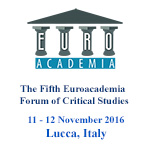Euroacademia Conferences
 Europe Inside-Out: Europe and Europeanness Exposed to Plural Observers (9th Edition) April 24 - 25, 2020
Europe Inside-Out: Europe and Europeanness Exposed to Plural Observers (9th Edition) April 24 - 25, 2020 Identities and Identifications: Politicized Uses of Collective Identities (9th Edition) June 12 - 13, 2020
Identities and Identifications: Politicized Uses of Collective Identities (9th Edition) June 12 - 13, 2020 8th Forum of Critical Studies: Asking Big Questions Again January 24 - 25, 2020
8th Forum of Critical Studies: Asking Big Questions Again January 24 - 25, 2020 Re-Inventing Eastern Europe (7th Edition) December 13 - 14, 2019
Re-Inventing Eastern Europe (7th Edition) December 13 - 14, 2019 The European Union and the Politicization of Europe (8th Edition) October 25 - 26, 2019
The European Union and the Politicization of Europe (8th Edition) October 25 - 26, 2019 Identities and Identifications: Politicized Uses of Collective Identities (8th Edition) June 28 - 29, 2019
Identities and Identifications: Politicized Uses of Collective Identities (8th Edition) June 28 - 29, 2019 The European Union and the Politicization of Europe (7th Edition) January 25 - 26, 2019
The European Union and the Politicization of Europe (7th Edition) January 25 - 26, 2019 7th Forum of Critical Studies: Asking Big Questions Again November 23 - 24, 2018
7th Forum of Critical Studies: Asking Big Questions Again November 23 - 24, 2018 Europe Inside-Out: Europe and Europeanness Exposed to Plural Observers (8th Edition) September 28 - 30, 2018
Europe Inside-Out: Europe and Europeanness Exposed to Plural Observers (8th Edition) September 28 - 30, 2018 Identities and Identifications: Politicized Uses of Collective Identities (7th Edition) June 14 - 15, 2018
Identities and Identifications: Politicized Uses of Collective Identities (7th Edition) June 14 - 15, 2018
European Cities and New Inhabitants: A Heritage Contribution by Migrants
-
-

-
Presentation speakers
- Stefania Scarsini, Architect, London, UK
Abstract:
Heritage is commonly associated to preservation and protection. These approaches make sure that we can share with future generations our past and its cultural and social value. Nowadays we are witnessing the migration of populations towards Europe seeking safety and a place where to start a new life. They carry no belongings, but they have a rich cultural background and memories that will help them keeping their identities alive. Intangible heritage is what their new homes will house. The tangible effect is that Europe will have an enriched heritage as the new communities will settle in. A heritage exchange is important for the European cities to be able to make the new citizens part of an existing community. Understanding each other and learning from each other is key for success. It is very important that the European cities are a community not a series of ghettos where the newcomers settle and live in isolation. Are we prepared for this exchange? How can we make sure that the tangible and intangible heritage of this process is preserved and protected for future generations? The newcomers may like to go back to their homes once safe and they will take with them, once again, memories of their experience in a country that accepted their culture and provided them with an experience that they will share with others. Heritage values are site specific, the European cities are transforming into new sites. By sharing our past and present, we could shape and retain the tangible and intangible heritage of this process for future generations.
-
Related Presentations

Self and Other in Podemos Discourse on the EU: A Discourse Historical Approach
- Catherine MacMillan

The Biopower of Neoliberalism
- Sebastian Ramirez













